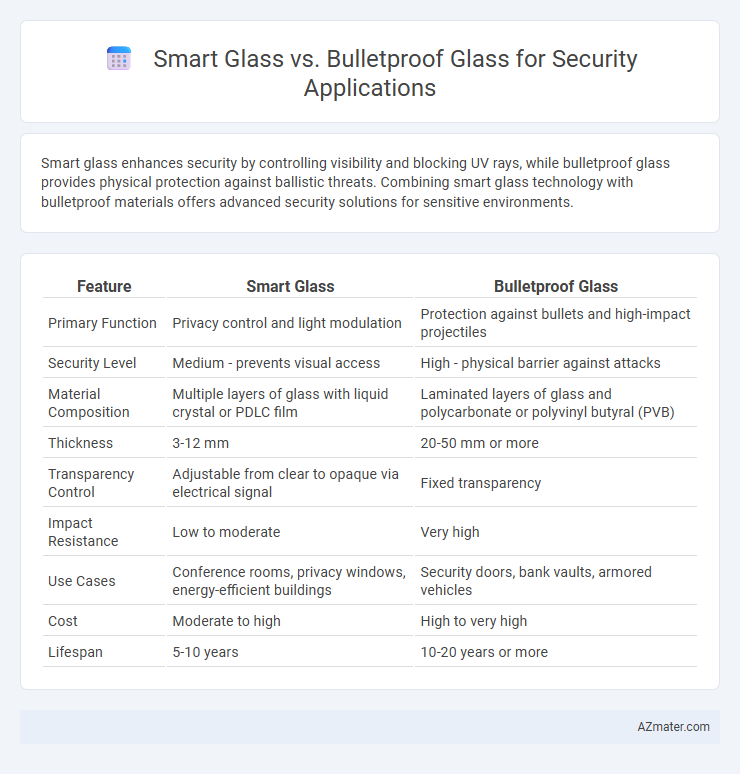Smart glass enhances security by controlling visibility and blocking UV rays, while bulletproof glass provides physical protection against ballistic threats. Combining smart glass technology with bulletproof materials offers advanced security solutions for sensitive environments.
Table of Comparison
| Feature | Smart Glass | Bulletproof Glass |
|---|---|---|
| Primary Function | Privacy control and light modulation | Protection against bullets and high-impact projectiles |
| Security Level | Medium - prevents visual access | High - physical barrier against attacks |
| Material Composition | Multiple layers of glass with liquid crystal or PDLC film | Laminated layers of glass and polycarbonate or polyvinyl butyral (PVB) |
| Thickness | 3-12 mm | 20-50 mm or more |
| Transparency Control | Adjustable from clear to opaque via electrical signal | Fixed transparency |
| Impact Resistance | Low to moderate | Very high |
| Use Cases | Conference rooms, privacy windows, energy-efficient buildings | Security doors, bank vaults, armored vehicles |
| Cost | Moderate to high | High to very high |
| Lifespan | 5-10 years | 10-20 years or more |
Introduction to Security Glass Technologies
Security glass technologies include smart glass and bulletproof glass, each offering distinct protective features for various applications. Smart glass enhances security by controlling transparency and privacy through electrochromic or thermochromic technology, allowing real-time light modulation without compromising strength. Bulletproof glass, composed of laminated layers of polycarbonate and glass, provides ballistic protection by absorbing and dispersing impact energy to prevent penetration.
What is Smart Glass?
Smart glass, also known as switchable glass, is an advanced glazing technology that alters its light transmission properties in response to electrical, thermal, or light stimuli, enhancing privacy and energy efficiency in security applications. Unlike bulletproof glass, which is designed primarily for impact resistance and ballistic protection through layered polycarbonate and laminated glass, smart glass provides dynamic control over visibility and glare. This capability enables secure spaces to manage transparency without compromising safety, making it ideal for environments requiring both protection and adaptable visual privacy.
What is Bulletproof Glass?
Bulletproof glass, also known as ballistic glass, is a laminated material designed to resist penetration from bullets and withstand high-impact forces for enhanced security in applications such as banks, government buildings, and armored vehicles. It consists of multiple layers of glass and polycarbonate materials that absorb and disperse the energy from ballistic impacts to prevent shattering. This specialized glass provides robust protection against firearm attacks, making it a critical component in environments requiring advanced security measures.
Key Differences: Smart Glass vs Bulletproof Glass
Smart glass offers dynamic opacity control for privacy and energy efficiency, while bulletproof glass provides high-impact resistance specifically designed to stop projectiles and prevent forced entry. Smart glass utilizes electrochromic or photochromic technology for adjustable transparency, whereas bulletproof glass comprises multiple layers of laminated glass and polycarbonate to absorb and disperse kinetic energy. Security applications prioritize bulletproof glass for physical threat protection, whereas smart glass is favored for environmental control and covert visibility.
Security Features Comparison
Smart glass and bulletproof glass serve distinct security purposes, with bulletproof glass providing physical protection through multi-layered polycarbonate and glass composites that resist ballistic impacts from firearms and explosives. Smart glass enhances security by enabling dynamic privacy control, glare reduction, and potential integration with alarm systems via switchable opacity technology, deterring unauthorized visual access without physical reinforcement. Bulletproof glass excels in preventing physical breaches, while smart glass offers adaptive visual security features, making them complementary in comprehensive security solutions.
Cost and Installation Considerations
Smart glass for security applications generally involves higher initial costs due to advanced technology integration, while bulletproof glass tends to have a lower upfront price but may require thicker, heavier materials impacting installation complexity. Installation of smart glass demands specialized electrical wiring and control systems, increasing labor and time, whereas bulletproof glass installation focuses more on structural support to handle the weight and impact resistance. Cost-effectiveness depends on the security needs and installation environment, balancing smart glass's multifunctionality against bulletproof glass's protective strength.
Durability and Maintenance
Smart glass offers moderate durability with resistance to scratches and impacts, yet requires regular maintenance to preserve its electrochromic or photochromic functions, including cleaning with non-abrasive materials and occasional electronic servicing. Bulletproof glass provides superior durability under extreme conditions, engineered with multiple layers of laminated glass and polycarbonate to withstand high-velocity projectiles, but it demands minimal maintenance, primarily focused on inspecting for cracks or delamination. For high-security applications where maximum impact resistance is critical, bulletproof glass is preferred due to its robust longevity and low upkeep requirements.
Applications in Modern Security Systems
Smart glass enhances modern security systems by providing dynamic privacy control and energy efficiency in secure facilities, preventing unauthorized visual access without compromising natural light. Bulletproof glass offers high-impact resistance and ballistic protection, making it essential for bank windows, government buildings, and armored vehicles where physical threat prevention is critical. Combining smart glass technology with bulletproof layers integrates visual security with robust defense, optimizing safety in high-risk environments.
Future Trends in Security Glass
Smart glass with embedded sensors and adaptive tinting technology is revolutionizing security applications by offering real-time threat detection and privacy control. Bulletproof glass advancements are focusing on lightweight, multi-layered composites with enhanced ballistic resistance and transparent armor capabilities for improved protection. Future trends emphasize integrating smart glass with AI-driven surveillance and impact-resistant materials, creating multifunctional security barriers that combine transparency, durability, and intelligence.
Choosing the Right Glass for Security Needs
Smart glass offers adaptive opacity and enhanced privacy features, making it ideal for environments requiring controlled visibility and energy efficiency. Bulletproof glass provides high-level ballistic resistance verified by standards such as UL 752, essential for protection against firearms and impact threats. Selecting between smart glass and bulletproof glass depends on security priorities: visibility control and environmental benefits versus physical protection and force resilience.

Infographic: Smart glass vs Bulletproof glass for Security application
 azmater.com
azmater.com